SAIC Motor Corporation Bundle
Who Buys SAIC Motor Cars?
The automotive industry is undergoing a massive transformation, and SAIC Motor Corporation is at the forefront. Understanding its SAIC Motor Corporation SWOT Analysis is key to grasping its market position. For SAIC, knowing its customer demographics and target market is not just an analysis; it's the foundation of its strategy. This knowledge is crucial for sustained success in a rapidly changing global landscape.
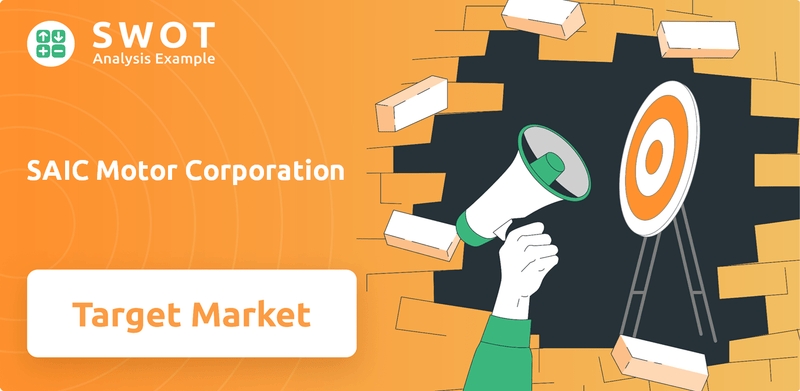
SAIC Motor's evolution from a domestic supplier to a global player demands constant re-evaluation of its customer base. This includes detailed insights into SAIC Motor customer profile, SAIC Motor target market, and Customer demographics SAIC Motor. This exploration dives deep into who SAIC's customers are, their locations, preferences, and how the company adapts its offerings. We'll examine SAIC Motor market analysis and SAIC Motor consumer behavior through a lens of SAIC Motor audience segmentation to provide a comprehensive understanding.
Who Are SAIC Motor Corporation’s Main Customers?
Understanding the customer demographics is crucial for the success of any automotive manufacturer, and SAIC Motor Corporation is no exception. SAIC Motor's target market is diverse, encompassing both individual consumers (B2C) and businesses (B2B). The company strategically segments its audience based on brand, vehicle type, and geographic location to effectively cater to different customer needs and preferences. This approach allows SAIC Motor to maximize its market penetration and sales across various segments.
The company's brand portfolio, including MG, Roewe, and Maxus, each targets distinct customer profiles. MG often appeals to younger demographics seeking stylish and value-for-money vehicles, while Roewe caters to a more mature, family-oriented demographic. Maxus serves both B2C and B2B markets, providing commercial vehicles for businesses. The joint ventures with Volkswagen and General Motors further broaden SAIC Motor's reach, targeting middle-to-high-income households with a wide range of passenger vehicles.
SAIC Motor's customer profile is also influenced by its focus on new energy vehicles (NEVs). The NEV segment has seen rapid growth, driven by environmental concerns and government incentives. In 2023, SAIC Motor's new energy passenger vehicle sales exceeded 1.12 million units, indicating a significant shift towards environmentally conscious consumers and businesses. This growth reflects the company's strategic adaptation to evolving market trends and consumer demand.
MG vehicles often attract younger buyers. These customers are typically looking for stylish, affordable cars with modern features. The brand's focus on value and design resonates well with this demographic, particularly in international markets. Owners & Shareholders of SAIC Motor Corporation benefit from this customer segment's contribution to sales volume.
Roewe primarily targets the Chinese domestic market. Its customer base tends to be more mature and family-oriented. These buyers prioritize reliability, advanced technology, and comfort in their vehicles. The brand's sedans and SUVs are designed to meet these specific needs.
Maxus serves both B2C and B2B segments. In the B2C market, it offers SUVs and MPVs. For businesses, Maxus provides commercial vans and pick-up trucks, catering to fleet solutions. This dual approach allows Maxus to capture a broader customer base.
Joint ventures with Volkswagen and General Motors target the B2C segment. These partnerships leverage established brand recognition. They provide a wide range of passenger vehicles, appealing to middle-to-high-income households across various age groups.
SAIC Motor's market segmentation strategy is designed to address diverse customer needs. The company's approach to customer demographics, including age range and income levels, is crucial for its success. This strategy helps SAIC Motor understand customer purchasing habits and preferences.
- Younger Demographics: Attracted by MG's style and value.
- Family-Oriented: Seeking reliability and technology in Roewe vehicles.
- Businesses: Utilizing Maxus for commercial fleet solutions.
- Middle-to-High-Income Households: Purchasing vehicles from joint ventures.
SAIC Motor Corporation SWOT Analysis
- Complete SWOT Breakdown
- Fully Customizable
- Editable in Excel & Word
- Professional Formatting
- Investor-Ready Format
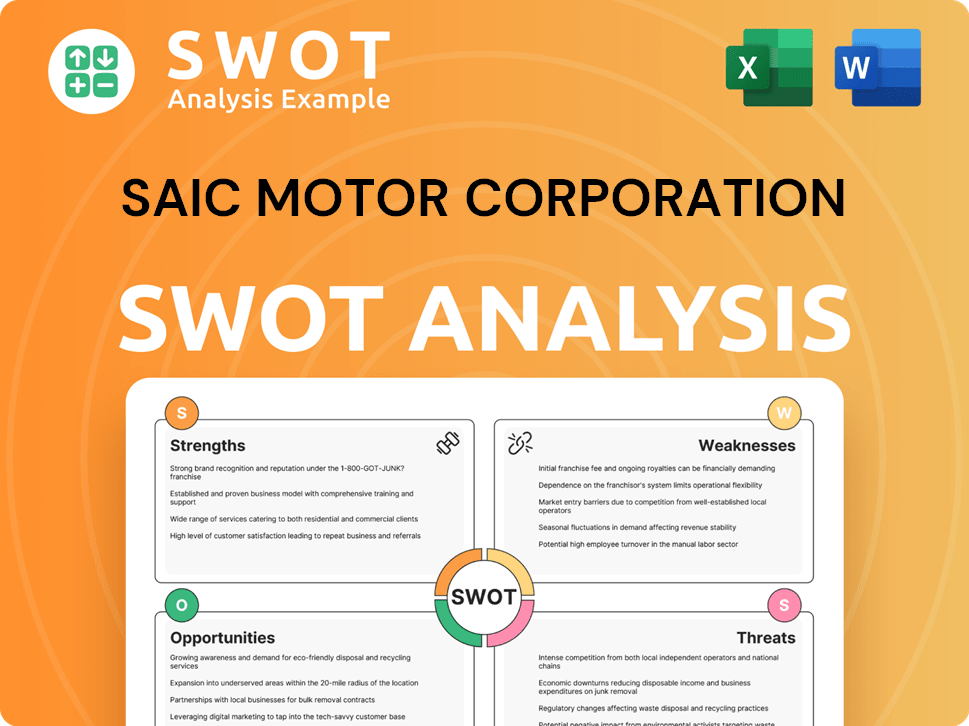
What Do SAIC Motor Corporation’s Customers Want?
Understanding the customer needs and preferences is crucial for the success of SAIC Motor. The company's approach involves a deep dive into the diverse motivations and preferences driving its customer base, both in the B2C and B2B segments. This involves analyzing factors such as affordability, design, technology, and sustainability preferences to tailor products and marketing strategies effectively.
For B2C customers, the purchasing decisions are influenced by a mix of practical needs, emotional desires, and aspirations. SAIC Motor focuses on understanding these drivers to offer vehicles that resonate with different customer segments. This includes considerations like the desire for status, technological advancements, and environmental responsibility, especially among electric vehicle (EV) buyers.
In the B2B sector, SAIC Motor concentrates on reliability, total cost of ownership, after-sales service, and the capacity to customize vehicles to meet specific business requirements. This strategic focus enables SAIC Motor to meet the varied needs of its customers, driving both sales and customer loyalty.
MG customers often seek affordability, modern design, and electric powertrain options. Roewe customers, particularly in China, prioritize advanced in-car technology, comfort, and safety features. The psychological drivers include the desire for status and environmental responsibility.
B2B customers prioritize reliability, total cost of ownership, after-sales service, and vehicle customization. Maxus addresses these needs by providing durable and versatile commercial vehicles for logistics and transportation.
SAIC Motor adapts to market trends by expanding its NEV lineup, including models like the MG ZS EV and Roewe Ei5. This directly addresses the growing demand for electric and hybrid vehicles. The company tailors marketing messages to highlight specific features for each target group.
Marketing messages highlight fuel efficiency for budget-conscious buyers and advanced driver-assistance systems for safety-conscious families. This shows how SAIC Motor tailors product features and marketing to specific segments and evolving preferences.
SAIC Motor continually gathers customer feedback and monitors market trends to influence product development. This ensures that the company remains responsive to changing customer demands and preferences.
The company tailors its marketing messages to highlight specific features that resonate with each target group. This includes fuel efficiency for budget-conscious buyers and advanced driver-assistance systems for safety-conscious families.
SAIC Motor's approach to understanding its customers is multifaceted, focusing on both current needs and future trends. This includes detailed market analysis to stay competitive. By continually gathering customer feedback and monitoring market trends, SAIC Motor ensures its products and marketing strategies align with evolving customer preferences. This customer-centric approach is crucial for maintaining and expanding its market share.
The primary drivers for SAIC Motor's customers include affordability, modern design, technological features, and sustainability. Different brands within SAIC Motor cater to specific preferences, such as MG focusing on cost-effectiveness and Roewe emphasizing advanced technology and safety.
- Affordability: A significant factor, especially for MG customers.
- Modern Design: Appealing to a wide range of customers, reflected in the aesthetic choices of various models.
- Technological Features: Advanced in-car technology, safety systems, and connectivity options are highly valued.
- Sustainability: Growing demand for electric and hybrid vehicles, as evidenced by the success of the MG ZS EV and Roewe Ei5.
SAIC Motor Corporation PESTLE Analysis
- Covers All 6 PESTLE Categories
- No Research Needed – Save Hours of Work
- Built by Experts, Trusted by Consultants
- Instant Download, Ready to Use
- 100% Editable, Fully Customizable
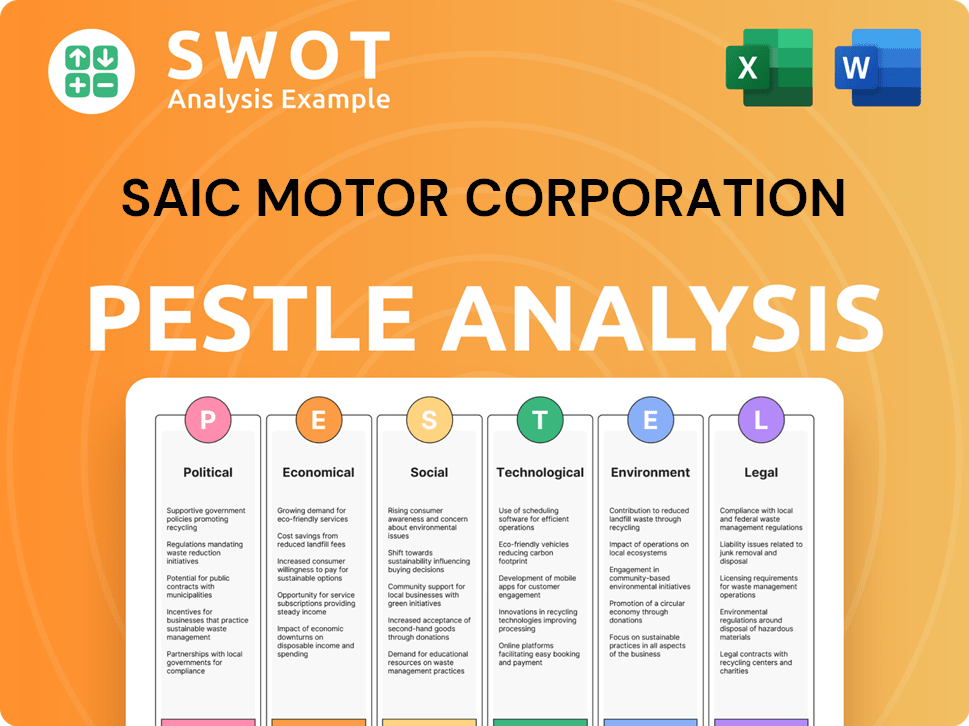
Where does SAIC Motor Corporation operate?
SAIC Motor Corporation's geographical market presence is notably strong, with its primary base in China. The company has cultivated a substantial market share within its home market, benefiting from robust brand recognition and an extensive dealership network. This strong domestic foundation provides a solid base for its global expansion efforts.
Beyond China, SAIC has strategically expanded its global footprint, particularly through its MG and Maxus brands. Key international markets include Europe, India, Australia, and parts of Southeast Asia and South America. This expansion strategy is tailored to meet the diverse needs and preferences of consumers in different regions.
SAIC Motor's approach to market segmentation involves adapting its offerings to suit diverse customer demographics and preferences across various regions. For instance, in Europe, the focus is on meeting the growing demand for value-for-money electric vehicles (EVs), while in emerging markets, the emphasis might be on affordability and build quality. This localized approach, including adapting vehicle specifications and marketing campaigns, is crucial for success.
SAIC Motor holds a significant market share in China, its home market. This strong position is a result of its established brand presence and extensive distribution network. The company's success in China provides a stable base for its international expansion initiatives.
In Europe, the MG brand has gained considerable traction, particularly with its EV models. MG Motor UK achieved record sales in 2023, selling over 80,000 cars, which represents a 14% year-on-year increase. This success is driven by catering to the demand for affordable EVs.
MG Motor India has established a strong presence in India by localizing its offerings. This includes adapting its products and manufacturing processes to meet the specific needs of the Indian market. This strategy has helped SAIC Motor to gain a foothold in the competitive Indian automotive market.
SAIC Motor is actively establishing overseas innovation centers and manufacturing bases. The company's plant in Thailand is one example of its commitment to localizing its strategies. These initiatives support its global sales network expansion and enhance its ability to serve diverse markets.
Understanding the Growth Strategy of SAIC Motor Corporation is crucial for appreciating its market presence. The company's success in international markets is a result of its ability to understand and adapt to local market conditions. This includes tailoring its products, marketing strategies, and even its manufacturing processes to meet the specific needs of each region. SAIC Motor's focus on customer demographics and its ability to segment its audience effectively are key factors in its global expansion.
European customers often prioritize stringent emission standards and advanced safety features. The MG brand has seen success by offering affordable and well-equipped EVs that meet these demands. SAIC Motor's focus on electric vehicles aligns with the growing European market trends.
Emerging markets, like India, may prioritize affordability and robust build quality. SAIC Motor adapts its offerings, including vehicle specifications and manufacturing processes, to meet these needs. This localization strategy is key to success in these diverse markets.
SAIC Motor employs a market segmentation strategy that involves adapting its products and marketing campaigns to suit the specific needs of each region. This approach helps the company to target different customer segments effectively. This customer profile is essential for the company.
SAIC Motor's target market for electric vehicles includes environmentally conscious consumers and those seeking value-for-money options. The company's focus on EVs, particularly in Europe, reflects this strategic direction. The company is focusing on the SAIC Motor target market.
SAIC Motor's customer purchasing habits are influenced by factors such as price, features, and brand reputation. The company's ability to offer competitive pricing and desirable features is crucial. The company is analyzing SAIC Motor customer behavior.
Customer preferences for car features vary by region. In Europe, safety and advanced technology are key. In emerging markets, reliability and affordability are often prioritized. SAIC Motor tailors its offerings to meet these diverse preferences. The company is doing a SAIC Motor market analysis.
SAIC Motor Corporation Business Model Canvas
- Complete 9-Block Business Model Canvas
- Effortlessly Communicate Your Business Strategy
- Investor-Ready BMC Format
- 100% Editable and Customizable
- Clear and Structured Layout
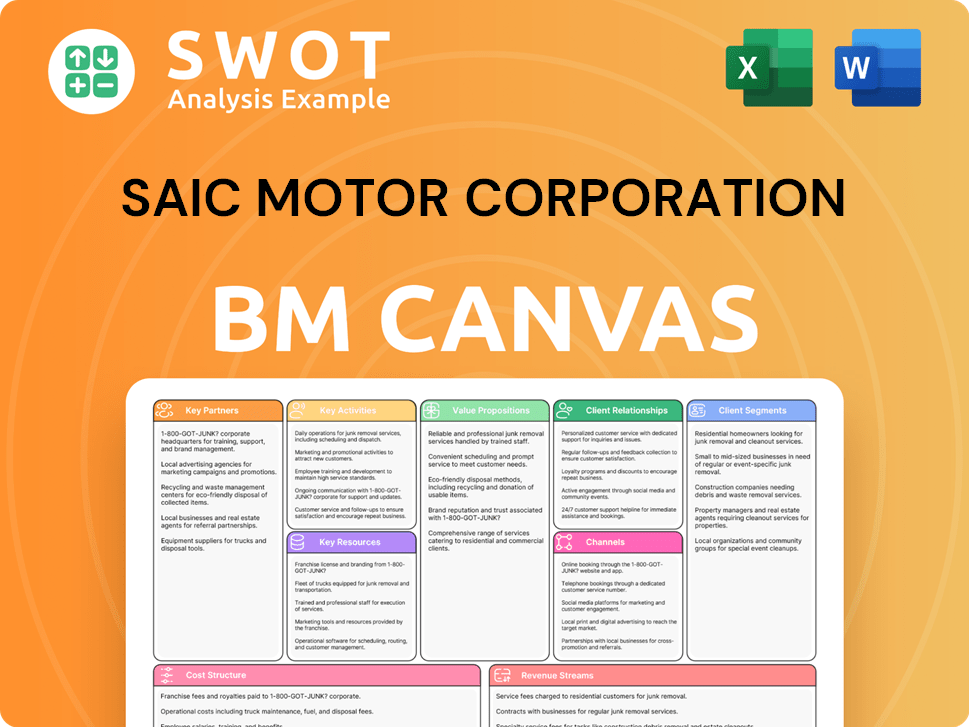
How Does SAIC Motor Corporation Win & Keep Customers?
SAIC Motor's customer acquisition and retention strategies are multifaceted, utilizing both traditional and digital marketing channels to reach its target market. The company focuses on extensive advertising campaigns across various platforms, including television, print, and digital media like social media. Furthermore, influencer marketing plays a significant role, particularly in promoting new vehicle launches and reaching younger demographics, especially for their electric vehicle (EV) models.
To acquire customers, SAIC Motor employs competitive pricing, attractive financing options, and promotional bundles, especially during key sales periods and for new model introductions. Customer retention is a key focus, supported by strong after-sales service, comprehensive warranty programs, and a widespread service network. Loyalty programs offer incentives for repeat purchases and preferential service, aiming to increase customer lifetime value.
SAIC Motor leverages customer data and CRM systems to personalize customer experiences and tailor marketing messages. This data-driven approach helps the company understand purchasing history, service records, and online interactions. By analyzing these factors, SAIC aims to increase customer lifetime value and enhance brand loyalty. For example, the company's connected car technologies allow personalized in-car experiences and over-the-air updates, enhancing customer satisfaction.
SAIC Motor invests heavily in advertising campaigns across diverse platforms. These campaigns are designed to reach different segments of the SAIC Motor target market. Digital platforms, including social media, are increasingly important for reaching younger demographics.
Influencer marketing is a key strategy, particularly for promoting new vehicle launches. This approach helps SAIC Motor connect with specific segments, especially for EV models. The use of influencers helps to build credibility and reach targeted audiences.
SAIC Motor utilizes competitive pricing strategies and promotional offers to attract customers. Attractive financing options and bundled deals are common, particularly during key sales events. These strategies are designed to drive sales and increase market share.
Robust after-sales service and loyalty programs are crucial for customer retention. These programs include extensive warranty programs and readily available spare parts. SAIC Motor aims to build long-term customer relationships through these initiatives.
SAIC Motor uses CRM systems to analyze customer data and personalize marketing efforts. This includes understanding purchasing history, service records, and online interactions. By tailoring marketing messages, SAIC aims to enhance customer satisfaction and loyalty.
- Data Analysis: Analyzing customer data to understand preferences and behaviors.
- Personalized Marketing: Tailoring marketing messages and offers to individual customers.
- Connected Car Technology: Utilizing connected car features for personalized experiences and updates.
- Online Communities: Building online communities to foster brand loyalty and user-generated content.
To understand the broader context of SAIC Motor's operations, it's helpful to review a Brief History of SAIC Motor Corporation. This provides insights into the company's evolution and its strategic decisions.
SAIC Motor Corporation Porter's Five Forces Analysis
- Covers All 5 Competitive Forces in Detail
- Structured for Consultants, Students, and Founders
- 100% Editable in Microsoft Word & Excel
- Instant Digital Download – Use Immediately
- Compatible with Mac & PC – Fully Unlocked
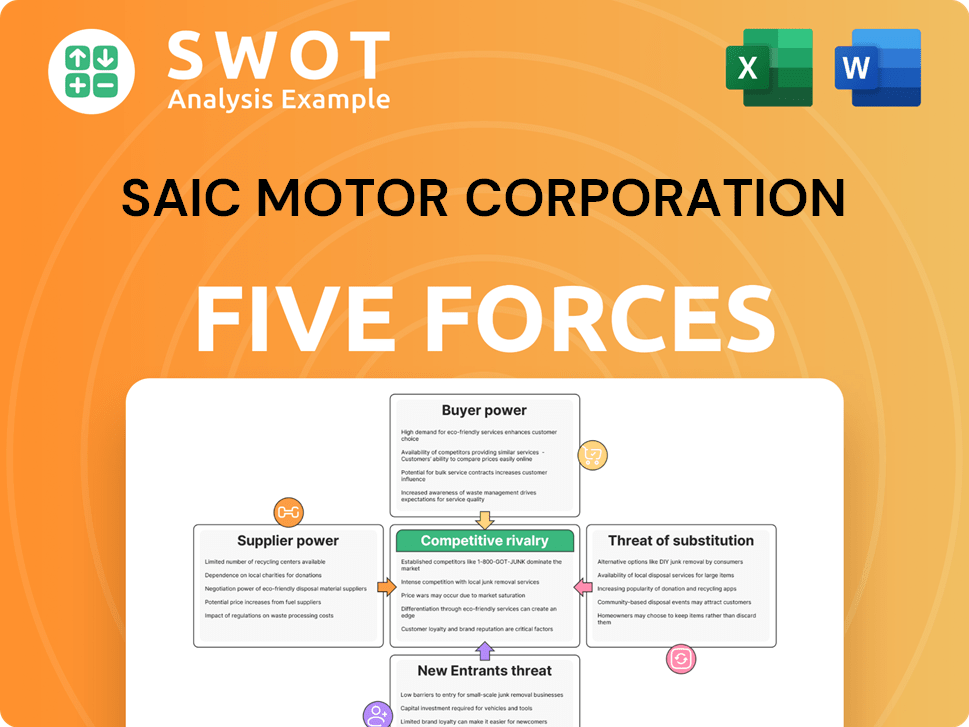
Related Blogs
- What are Mission Vision & Core Values of SAIC Motor Corporation Company?
- What is Competitive Landscape of SAIC Motor Corporation Company?
- What is Growth Strategy and Future Prospects of SAIC Motor Corporation Company?
- How Does SAIC Motor Corporation Company Work?
- What is Sales and Marketing Strategy of SAIC Motor Corporation Company?
- What is Brief History of SAIC Motor Corporation Company?
- Who Owns SAIC Motor Corporation Company?
Disclaimer
All information, articles, and product details provided on this website are for general informational and educational purposes only. We do not claim any ownership over, nor do we intend to infringe upon, any trademarks, copyrights, logos, brand names, or other intellectual property mentioned or depicted on this site. Such intellectual property remains the property of its respective owners, and any references here are made solely for identification or informational purposes, without implying any affiliation, endorsement, or partnership.
We make no representations or warranties, express or implied, regarding the accuracy, completeness, or suitability of any content or products presented. Nothing on this website should be construed as legal, tax, investment, financial, medical, or other professional advice. In addition, no part of this site—including articles or product references—constitutes a solicitation, recommendation, endorsement, advertisement, or offer to buy or sell any securities, franchises, or other financial instruments, particularly in jurisdictions where such activity would be unlawful.
All content is of a general nature and may not address the specific circumstances of any individual or entity. It is not a substitute for professional advice or services. Any actions you take based on the information provided here are strictly at your own risk. You accept full responsibility for any decisions or outcomes arising from your use of this website and agree to release us from any liability in connection with your use of, or reliance upon, the content or products found herein.